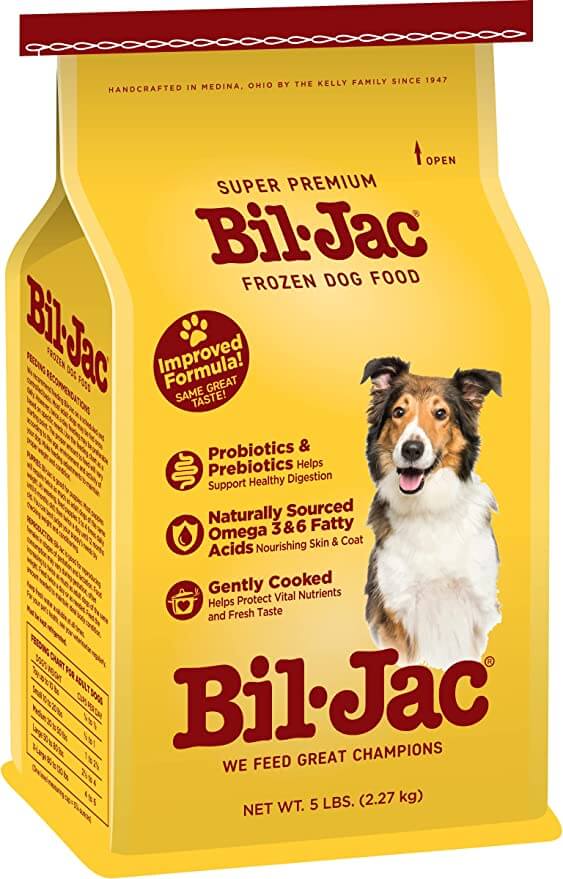
DogFoodAdvisor is reader supported See how
All reviews are 100% impartial but if you buy using links on this page, we may earn a referral fee.
Review of Bil-Jac Frozen Dog Food
Bil-Jac Frozen Dog Food receives the Advisor’s mid-tier rating of 3 stars.
The Bil-Jac product line includes one frozen dog food, a recipe claimed to meet AAFCO nutrient profiles for all life stages.
Bil-Jac Frozen Dog Food
Estimated Dry Matter Nutrient Content
Protein
Fat
CarbsCarbohydrates
Chicken, wheat flour, beef tripe, chicken meal, beef liver, chicken liver, dried beet pulp, cane molasses, brewers dried yeast, phosphoric acid, choline chloride, fish oil, cellulose gum, dl-methionine, l-lysine monohydrochloride, citric acid and calcium propionate (preservatives), potassium chloride, eggs, dried Lactobacillus acidophilus fermentation product, dried Lactobacillus casei fermentation product, dried Bifidobacterium animalis fermentation product, dried Lactobacillus reuteri fermentation product, fructooligosaccharide, zinc proteinate, vitamin E supplement, l-ascorbyl-2-polyphosphate (source of vitamin C), manganese proteinate, zinc sulfate, ferrous sulfate, iron proteinate, inositol, niacin supplement, copper proteinate, sodium selenite, d-calcium pantothenate, copper sulfate, riboflavin supplement, vitamin A acetate, biotin, thiamine mononitrate, pyridoxine hydrochloride, vitamin B12 supplement, manganous oxide, cobalt proteinate, vitamin D3 supplement, cobalt carbonate, calcium iodate, folic acid
Fiber (estimated dry matter content) = 2.5%
Red denotes any controversial items
| Estimated Nutrient Content | |||
|---|---|---|---|
| Method | Protein | Fat | Carbs |
| Guaranteed Analysis | 18% | 8% | NA |
| Dry Matter Basis | 33% | 15% | 45% |
| Calorie Weighted Basis | 29% | 31% | 40% |
Ingredient Analysis
The first ingredient in this dog food is chicken. Chicken is considered “the clean combination of flesh and skin… derived from the parts or whole carcasses of chicken”.1
Chicken is naturally rich in the ten essential amino acids required by a dog to sustain life.
The second ingredient is wheat flour, a highly-refined product of wheat milling. Like corn, wheat is an inexpensive and controversial cereal grain of only modest nutritional value to a dog.
For this reason, we do not consider wheat a preferred component in any dog food.
The third ingredient is beef tripe. Tripe usually consists of the first three chambers of a cud-chewing animal’s stomach. As unappetizing as it may seem to us humans, tripe is favored by dogs and sometimes even includes the stomach’s contents, too.
The fourth ingredient is chicken meal. Chicken meal is considered a meat concentrate and contains nearly 300% more protein than fresh chicken.
The next two items are beef liver and chicken liver. These are organ meats sourced from named animals and thus considered beneficial components.
The seventh ingredient is beet pulp. Beet pulp is a controversial ingredient, a high fiber by-product of sugar beet processing.
Some denounce beet pulp as an inexpensive filler while others cite its outstanding intestinal health and blood sugar benefits.
We only call your attention here to the controversy and believe the inclusion of beet pulp in reasonable amounts in most dog foods is entirely acceptable.
The eighth ingredient is molasses, which can be rich in minerals. However, it’s also a less refined form of sugar with a glycemic index in humans similar to maple syrup.
Like table sugar (and in excessive amounts), molasses has the potential to raise a dog’s blood sugar.
From here, the list goes on to include a number of other items.
But to be realistic, ingredients located this far down the list (other than nutritional supplements) are not likely to affect the overall rating of this Bil-Jac product.
With 5 notable exceptions…
First, we find brewers yeast, which can be a controversial item. Although it’s a by-product of the beer making process, this ingredient is rich in minerals and other healthy nutrients.
Fans believe yeast repels fleas and supports the immune system.
Critics argue yeast ingredients can be linked to allergies. This may be true, but (like all allergies) only if your particular dog is allergic to the yeast itself.
In addition, a vocal minority insists yeast can increase the risk of developing the life-threatening condition known as bloat. However, this is a claim we’ve not been able to scientifically verify.
In any case, unless your dog is specifically allergic to it, yeast can still be considered a nutritious additive.
What’s more noteworthy here is that brewers yeast contains about 48% protein, a factor that must be considered when judging the actual meat content of this dog food.
Next, we note the inclusion of dried fermentation products in this recipe. Fermentation products are typically added as probiotics to aid with digestion.
In addition, eggs are easy to digest and have an exceptionally high biological value.
Next, this recipe contains sodium selenite, a controversial form of the mineral selenium. Sodium selenite appears to be nutritionally inferior to the more natural source of selenium found in selenium yeast.
And lastly, this recipe includes chelated minerals, minerals that have been chemically attached to protein. This makes them easier to absorb. Chelated minerals are usually found in better dog foods.
Nutrient Analysis
Based on its ingredients alone, Bil-Jac Frozen Dog Food looks like an above-average product.
The dashboard displays a dry matter protein reading of 33%, a fat level of 15% and estimated carbohydrates of about 45%.
And a fat-to-protein ratio of about 44%.
Which means this Bil-Jac product contains…
Near-average protein. Below-average fat. And above-average carbs when compared to a typical moist dog food.
Even when you consider the protein-boosting effect of the brewers dried yeast, this still looks like the profile of a frozen product containing a moderate amount of meat.
Our Rating of Bil-Jac Frozen Dog Food
Bil-Jac is a grain-inclusive pasteurized-then-frozen dog food using a moderate amount of named meat and meat meal as its dominant source of animal protein, thus earning the brand 3 stars.
Recommended.
Bil-Jac Dog Food Recall History
The following automated list (if present) includes all dog food recalls related to Bil-Jac through April.
- Bil-Jac Dog Food Recall (8/24/2012)
You can view a complete list of all dog food recalls since 2009 here.
Get Free Recall Alerts
Get free dog food recall alerts sent to you by email. Subscribe to The Advisor’s recall notification list.
More Bil-Jac Reviews
The following Bil-Jac dog food reviews are also posted on this website:
- Bil-Jac Dog Food Review (Dry)
- Bil-Jac Farmer’s Bounty Dog Food Review (Dry)
- Bil-Jac Pate Platters Dog Food Review (Canned)
- Bil-Jac Picky No More Dog Food Review (Dry)
- Bil-Jac Stews Dog Food Review (Tubs)
Compare This Dog Food
How does this brand compare with The Dog Food Advisor's most recommended brands?
A Final Word
The Dog Food Advisor does not accept money, gifts, samples or other incentives in exchange for special consideration in preparing our reviews.
However, we do receive a referral fee from online retailers (like Chewy or Amazon) and from sellers of perishable pet food when readers click over to their websites from ours. This helps cover the cost of operation of our free blog. Thanks for your support.
For more information, please visit our Disclaimer and Disclosure page.








